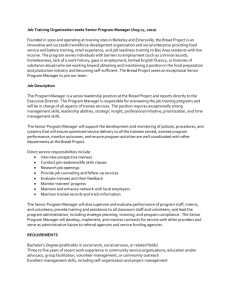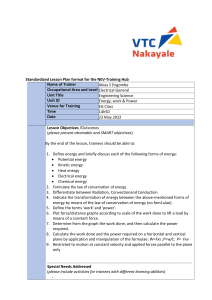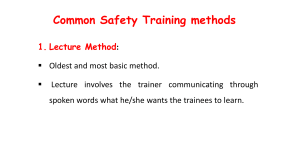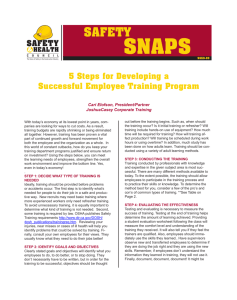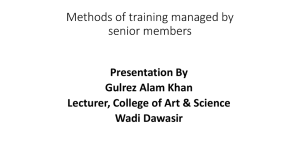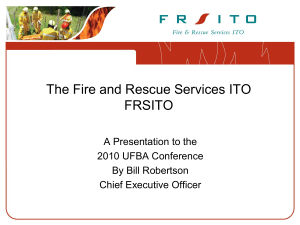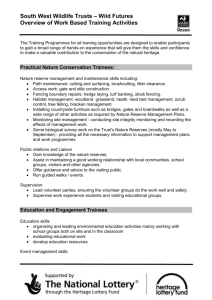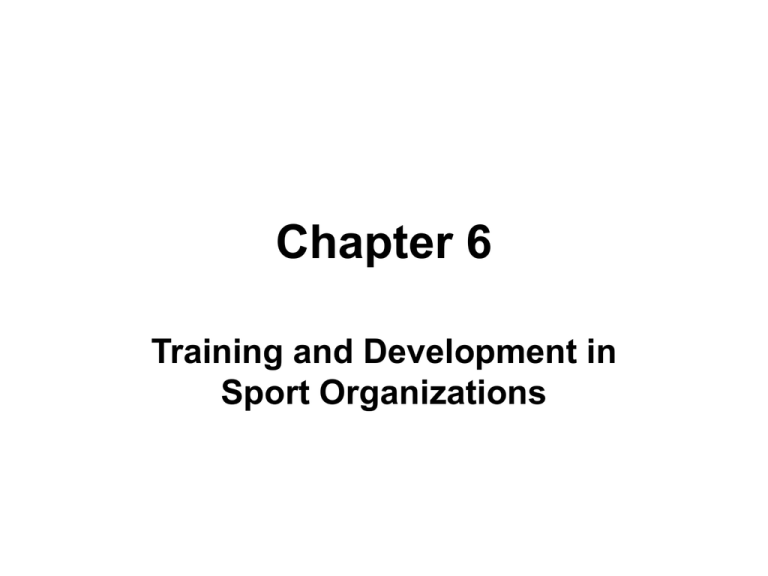
Chapter 6
Training and Development in
Sport Organizations
Learning objectives
• Understand the significance of training and
development in sport organisations
• Understand the aim of employee and volunteer
learning
• Explain the training and development model
• Describe how effective training and development
contributes to organisational development and
enables strategic achievement of organisational
goals
training and development
• Increased job satisfaction and morale among
employees and volunteers
• Reduced turnover of employees and volunteers
• Increased employee and volunteer motivation
• Improved efficiencies in processes and
procedures
• Enhanced capacity to adopt new technologies
and methods
• Risk management in terms of better knowledge
of compliance requirements
Common reasons for T&D
• To train about a specific topic or skill
• As a component of an individual’s overall
professional development program
• When a performance appraisal indicates that
performance improvement is required
• As part of a succession management or a
strategic talent management process
• As a way of developing a common and shared
mindset and approach to decision making
amongst managers
learning orientations
1. Behavioural - changing observable behaviour
2. Cognitive - mental processes
3. Constructive - (i) the duration of the change is
long-term; (ii) the change involves the content
and structure of knowledge in memory or the
behavior of the learner; and (iii) the cause of
the change is the learner’s experience in the
environment (Mayer, 1982)
The learning organisation
• “members are continuously deliberately
learning new things. They apply what they
learn to improve the product or service
quality, the processes involved in making
the product or providing the service, the
quality of the environment in which
employees work and the performance of
members of the organisation” (Honold,
1991, p. 56)
Training and Development Model
Training Needs Analysis
Determination of Training Goals
Evaluation
•
•
•
•
reduction of failure rate
improvement of performance
addressing HR needs
development of a competent workforce
Training Design: content, methods,
media and sequence
Baumgarten 1995, p. 209
Implementation:who, when and where
Step 1: Training needs analysis
• (i) an organisational level analysis
examines how a training and development
program can support the strategic goals
• (ii) an operational task analysis identifies
the nature of job tasks and the knowledge,
skills and abilities required to perform the
job effectively
• (iii) an individual level analysis determines
how well a person performs a job
Step 2: Setting training and
learning goals
• will arise out of gaps and deficiencies
identified in the preceding needs analysis
• indicate expectation in relation to
understanding of relevant concepts, ability
to perform a skill or demonstrate a change
in behaviour
• Be written as observable and measurable
learning objectives
Step 3: Designing training and
development
• content, method of instruction, material,
exercises and sequencing
• three general categories of skills and
tasks: cognitive, interpersonal and
psychomotor
• methods are chosen to match the skill or
task required
Lecture
Mostly an oral presentation, but may be supplemented with visual aids or handouts The technique is generally confined
to presenting only the expert’s point of view Often used because it is easier to organize and a great deal of information
can be presented in a short period of time
Useful when there are a large group of trainees
Lecture/Discussion
Variation of the lecture where the trainer increases trainee participation through facilitation of discussion at set times
during the session Discussion is often initiated through the use of questions Trainer must plan the discussion and
carefully choose the questions to lead the discussion
Demonstration
Oral explanations combined with visual activities Method demonstrations show processes, concepts and facts and are
especially effective in teaching a skill that can be observed
A result demonstration shows the outcome of some practice or innovation
Group discussion
Trainer leads the trainees as a group through a discussion of a given topic May or may not be preceded by a short
explanatory lecture
Symposium
A series of lectures presided over by a moderator Allows for the presentation of several points of view or several related
topics
Panel
A dialogue among several experts sitting in front of the room
A moderator coordinates the discussion
Differs from a symposium because panel members have an opportunity to discuss and interact with each other’s ideas
and views
Forum
Following one or more presentations, the audience interacts and discusses the topic(s), bringing up a wider range of
views
Discussion groups encourage/allow everyone to participate, even if the audience is large
Case studies
Information is given to the trainees detailing a specific situation or problem and the trainees are assigned (as
individuals or discussion groups) the task of making recommendations for the most appropriate action to
solve the problem
Introduces a practical aspect to the training environment and creates a problem solving situation similar to
that many trainees may face after returning to work
Simulations and
Games
Ranges from simple individual or small group problem-solving experiential exercises to complex multidimensional business simulations.
Contains a planned sequence of developmental activities Simulations allow the participant to observe the
impact of their choices without the outcomes having any impact on the real organisation
Employee and volunteer
development
• trainee positions, job rotation, leadership
and management development programs,
mentoring and coaching
Mentor
Coach
Focus
Individual
Enhance Performance
Role
Facilitator with no agenda
Specific agenda
Relationship
Self selecting
Assigned
Source of influence
Perceived value
Position
Personal returns
Affirmation/learning
Teamwork/performance
Arena
Life
Task related
Leadership development
• on-the-job training, external short courses,
special projects, residential courses and
executive development courses
• Use of internal processes or externally by
training companies, government bodies or
universities
• Included team building and other related
development initiatives
Career planning and
development
Development Cycle
Success
Profile
Measure and
Monitor Success
Create and Implement
Development Plan
Development Dimensions International Inc, MMI. All rights reserved.
Assess and
Diagnose
Business Strategy
Vision
Values
Critical Success
Factors
Performance
Feedback
Step 4: Training and development
evaluation
Evaluation criteria
Level
Assessment
measurement
1. Reaction
What does the participant
feel about the training?
Self-reporting of affective
and attitudinal responses
to the training
2. Learning
What facts, knowledge,
understandings, were
gained?
Performance tests
3. Behaviours
What skills were
developed?
Supervisor rating
4. Results or effectiveness
What results occurred?
Utility analyses
(Adapted from Kirkpatrick, 1976)
Summary
• A supportive learning environment & training and
development can lead to improved employee
satisfaction, retention and motivation
• Training - acquisition of knowledge, skills, and
competencies
• Development - new attitudes and behaviours
• Effective training and development benefits the
individual, other employees and volunteers,
managers and aligns with strategic directions of
the sport organisation


